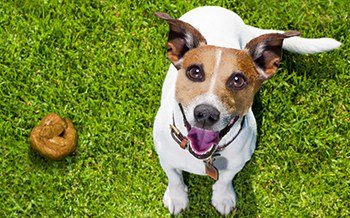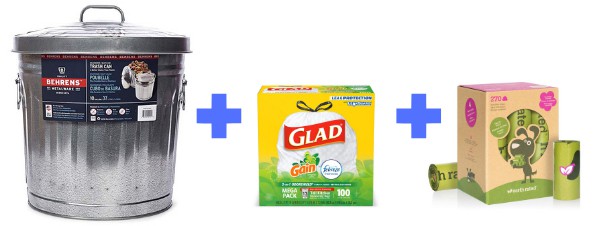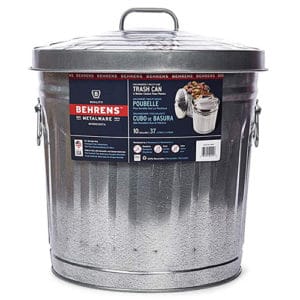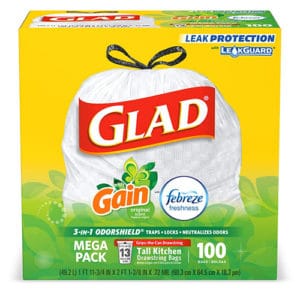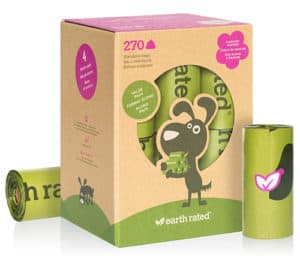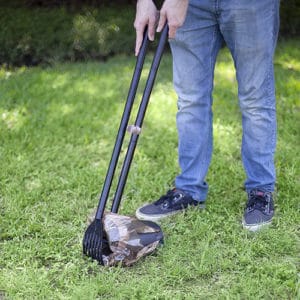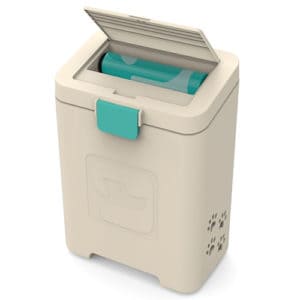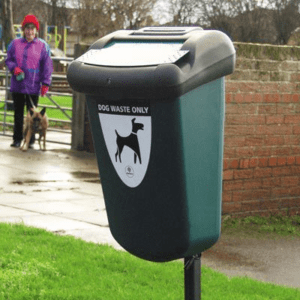So it’s come to this. You’re clicking on articles telling you how to get rid of dog poo. Don’t despair! Getting rid of your dog’s waste is something all dog owners have to deal with. I did recently and now I’m here to share what I’ve learned.
Our dog Chachi is 7 months old now. He poops. Daily. And I have to clean it up. He’s very cute so we are keeping him anyway. A few weeks back, after cleaning his mess, I kinda got fed up with the smell. We had been just putting it in an ‘odor-free’ bag and into the kitchen garbage.
Turns out, the odor-free bags weren’t cutting it. I remember saying to my wife that there has to be Diaper Genie kind of thing for dogs. For those without kids, Diaper Genie is just that bin you’d put the dirty diapers in to contain the smell.
ANYWAY… that led me to research this problem. What are other people doing? How can we make this simple and smell-free? Here then, is my answer to the dog owners eternal question:
What’s the best way to dispose of dog poop? For my family, the best option is a steel can outside and standard “odor guard” kitchen trash bags to line the can. Pick up the dogs mess with a biodegradable dog bag, put it in the can. Close the lid. Done.
Put the trash bag out with the other trash on pick-up day. I’ve also added some of those carbon air filter bags in the can for extra odor-fighting power.
The Best Option for Home Owners with a Back Yard:
Here’s What To Buy…
STEEL CAN: Behrens Galvanized Steel Can With Lid — I really like this one because it’s a perfect size, it has a lid that seals up nicely, and it’s metal. It gets great reviews and a lot of people use it for just this purpose. It’s durable and does the job for not a lot of money. Done and done.
KITCHEN BAGS: I mean if you already have these just use what you have! If you need a recommendation though, I like the Glad bags with Odorshield. They don’t rip, help with smell, and have the cinch sack things on them. Glad 13 Gallon Kitchen Trash Bag with Odorshield
DOG POOP BAGS: Earth Rated Dog Poop Bags — Highly rated, thick, odor-free, easy to open, and biodegradable. These are great and again, they get the job done. Bonus: You can use them on dog walks…just buy a dispenser like this for your leash.
Carbon Air Filters (optional): Throw a carbon air filter into the bottom of the can for extra odor-fighting power. I use these guys: Bamboo Charcoal Air Purifying Bags Variety 4 Pack
I occasionally spray with Lysol too. I think I get that from my Mom. I don’t know if it’s really necessary though.
Low Doodoo Tolerance Option
Get yourself a Pooper scooper. This is the “Get that Sssssssstuff away from me” choice. If you’re not quite at the point where you wouldn’t touch it with a 10-foot pole and might touch it with a 4-foot pole, this is for you. I like this guy: Petmate 71034 Arm & Hammer Pooper Scooper
Then when people stop me and say… “Whoa Rich nice pooper scooper there.” I can be like “Yeah, that’s the Petmate 71034. Ain’t she a beaut?”
ALSO, it’s good if you don’t want to be bending down all the time!
I don’t use the scooper much (yet) but I do have the can, bags and carbon things in there. We do have a fenced-in backyard and it’s a simple set up next to our other trash and recycle cans. If you’re in a slightly different situation, maybe you walk your dog around the block or live in an apartment, I’ll go through some options for you.
The Big Three of Dog Poop Disposal:
Trash/Garbage: Dog poop bags into the garbage. Popular, simple and effective.
This is the set up I use as described above. If you can find a place outside to put the can, you’re set. The smaller can is what works for me because I can put a regular kitchen trash bag in there and it’s ready to go each week. Our dog is only 15-20 lbs but I feel like that can will hold even a gigantic dogs turds for a week.
Flushing: Same concept but either putting the waste itself, or the waste in a flushable bag, and down the toilet.
The flushing one intrigues me but I’m not using this method. I still have trust issues from the whole “flushable wipes” incident in our home. It involves plumbers, snaking the drain, and loss of substantial amounts of dollars in service fees.
Now if you’re up to the task of picking it up, transporting into the bathroom and flushing just the waste, that would seem ideal. Alas, that’s a bit much for me.
Composting: This option has the most upfront work. Only a good method if you know what you’re doing.
I researched this one a bit. My Dad composts his lawn clippings and stuff, but not dog poop. I’ll give more info below but basically, dog droppings have bacteria and other badness that you cant use for a garden. I also live in a town where it’s hip to say you compost and are personally saving the environment. Really though, this was all beyond me. It seemed like a lot to go through for no real benefit.
If you know what you’re doing and have the drive to do it, go for it! These are popular on Amazon, maybe you’ve heard of it? And do me a favor and reach out to us with what you’re doing so I can share. Basically, you dig a hole, put this thing in, scoop your poop into it. Put in a bit of water and the enzyme digester stuff in there. Then it drains. Again if you do this let me know. I’ll totally do a tutorial on it!
The Best Option for an Apartment
Just the Basics: Apartment/Condo people… I feel you. If you have to keep it in the apartment til garbage day. Do what you gotta do. When we were at our condo there was a dumpster in back that we could keep a can set up like the one I outlined above. So if that’s an option for you, do that. If not, you can use a diaper genie instead!
Then there is this beast for 150 bucks if you’re not fooling around: PawPail Pet Waste Station
It’s got a built-in carbon filter, mounts to walls, I think it syncs up with a satellite to locate any dog poop in the yard you missed. Ok, maybe not that last part.
Another option to be aware of are the public dog waste bins like this one:
If that’s around you, use that!
Are you feeling like you STILL haven’t read enough about dog crap today? Fear not. Below we will answer questions like is it biodegradable, can I use it in my garden (ew, no), can I just leave it there? And we’ll ‘flush’ out the flushing option for you, too.
Is Dog Waste Biodegradable?
There are some rather frightening statistics out there about dog poop. 40% of Americans don’t pick up their dog’s poop. Of that 40%, 44% wouldn’t even pick up the poop if they were asked to do it.
That’s a lot of poop just laying around the yard, parks, walking trails, and other locations. While this may not seem like such a big deal aside from the smell and potentially stepping in it, dog poop that’s just laying around is a problem.
Because of the amount of toxic material in their waste, the EPA actually considers dog poop to be as hazardous to the environment and to humans as a chemical or oil spill. Clearly, picking up the poop is the method to utilize. Don’t let it just sit outside.
In terms of the inside of the home, it isn’t going to do anyone favors there either. For one, no one wants that odor occupying the house. Secondly, the longer it rests on the carpet or another flooring material, the more it’s permeating into the layers below. Fecal matter degrades slowly indoors and while it may not seem as though it’s going anywhere, it’s slowly becoming entrenched in the flooring material.
For homes that have small children, you’re essentially keeping toxic material within easy reach of their curious hands. It’s also common for children to track in toxic material via dog waste by stepping in it in the yard and tracking it through the house. Children should be taught about the dangers of dog poop, so they know to leave it alone or help pick it up safely.
Should I Use Biodegradable Dog Poop Bags?
Clearly, the best option is to pick up dog waste and throw it away. The method for doing so may seem a little unclear. What you use to pick up waste is just as important as picking up the waste itself.
The go-to for picking up dog poop is simple plastic bags. The problem is that the choice contributes further to the problem of plastic in the environment. While it may safely collect the waste and keep it inside of the bag, your responsibility for it doesn’t end just because you threw it away.
When it’s taken to the landfill, the plastic will either take years to actually degrade or, once it does degrade, release harsh chemicals into the environment.
Since you’re using plastic bags to get rid of waste, it’s unlikely that you’re going to place that bag into the recycling bin, too. After all, dog waste isn’t recyclable. However, a plastic bag is.
Plastic continues to be one of the fewest materials actually recycled in the country. Considering how much a dog poops, that’s a lot of plastic ending up in the landfill or a lot of plastic not being taken to be recycled.
Instead, biodegradable bags are the best choice to get rid of dog poop. There are a few main advantages of using biodegradable bags. The first is that these bags don’t pollute the environment when they degrade.
It also means that the dog poop inside of the bags can degrade in an area where toxic material can be safely disposed of rather than out in the open or in a recycling center. Landfills typically are prepared to deal with toxic materials as they come in. Although it doesn’t hurt to keep your dog waste trash separate and actually take it to a toxic material disposal site yourself either.
Can You Flush Dog Poop Bags?
Another method that you might want to consider is taking that bagged poop and flushing it down the toilet. It certainly seems like an easy process. However, it isn’t always the best course of action to take.
When using plastic or non-biodegradable bags, the material can actually get stuck in the pipes. It doesn’t flow through water very well. If the poop inside of the bag is rather large, the bag might have an even more difficult time of moving through the pipe.
As a result, both the plumbing line and the sewage tank itself might end up clogged. This is especially true in the event that you flush a lot of bags down the toilet. Considering that a dog usually poops at least once a day, that’s a lot of bags filling up your tank in a year.
The amount that’s inside of it could break the tank. The next thing you know, you have a lot of waste filling up your yard and potentially flooding into your basement.
What about biodegradable bags? There are some bags that have been designed to be able to degrade in water. They claim that they are safe to use on most plumbing systems. Even those with old plumbing systems shouldn’t have a problem.
et they also claim that if homeowners have been warned not to flush flushable wet wipes down their toilet, then they likely shouldn’t use water-soluble pet waste bags either. Most plumbers would likely say that no one should flush flushable wet wipes down the toilet.
That makes knowing whether or not to use biodegradable bags a bit more confusing. When in doubt, it’s likely better to go without the bag. Unless, of course, you want to risk the health of your sewage system.
When it comes down to it, the best method for the toilet is to actually throw the waste itself into the toilet and flush it without anything else. You can procure a poop scooper, scoop up the poop, and then simply drop it into the toilet.
In fact, the EPA considers flushing dog waste to be the best method for disposing of it. It makes sense, too, considering that human waste also goes to the septic tank. The waste can be broken down and eventually brought to a wastewater filtration center.
The next time your dog poops, do away with the bags and simply flush it down the toilet.
Is Dog Poop Good for Gardens?
No. A common myth is that dog poop can act as a good fertilizer. That isn’t true. It actually poses serious health issues for both the garden and the water that the family drinks. When dog poop is allowed to compost on its own or is just left in the garden, rain washes the dog poop into the soil.
This might seem like a great way to nourish the soil. In fact, the garden is suddenly introduced to all of the bacteria and viruses that reside within the poop.
Furthermore, those bacteria and viruses end up trickling into the water system. For those who use well water and without a filter, you’re essentially drinking liquified dog waste. In fact, dog waste is considered the #3 reason behind water pollution.
In order for dog waste to be used as something like compost, it has to be composted with other things like eggshells and grass clippings. It also has to compost for a very long time before it’s considered safe enough to use. Even then, it may still be hazardous.
Can I Leave Dog Poop in My Yard?
Similar to the garden, if you leave poop in the yard, that also allows toxic material to enter your water. It also enters the water systems around you. Neighbors, even the community itself, could be exposed to toxic material from the dog’s poop. Furthermore, it also leaves children susceptible to picking up disease. If they play in the yard and step in the poop, that contact could make them ill.
It may seem easy to just leave the poop in the yard and let nature do its thing. However, the risk of sickness is too high. Don’t place yourself or your children at risk. Instead, flush the poop in the toilet or throw it out to be gathered as toxic material.
Dog poop will decompose which makes it seem like it might be biodegradable. However, when it decomposes, it also releases toxic bacteria and viruses into the soil. To put that into further perspective, 1 gram of dog poop contains 23 million fecal bacteria.
Some of those bacteria and viruses include campylobacteriosis. If infected by this, y you’ll experience fever, vomiting, and swollen lymph nodes. Another popular pollutant in dog waste is Salmonellosis. If this gets into your body, you’ll experience fever, lethargy, dehydration, shock, and a lot more.
Last update on 2024-04-29 at 04:48 / Affiliate links / Images from Amazon Product Advertising API

